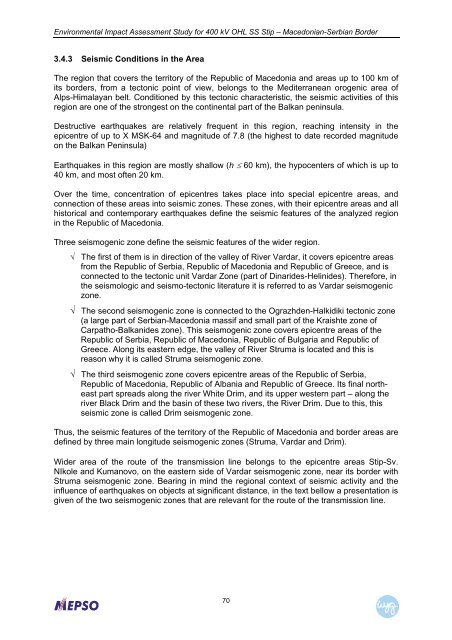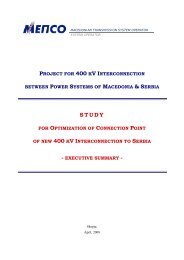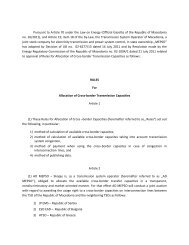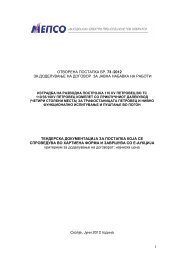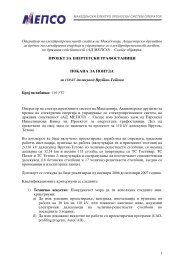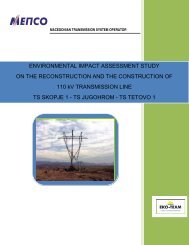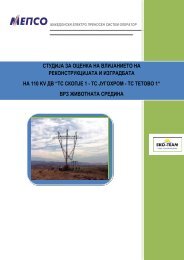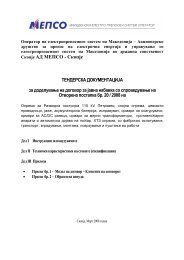Part A - EIA 400 kV OHTL Stp - мепÑо а.д.
Part A - EIA 400 kV OHTL Stp - мепÑо а.д.
Part A - EIA 400 kV OHTL Stp - мепÑо а.д.
Create successful ePaper yourself
Turn your PDF publications into a flip-book with our unique Google optimized e-Paper software.
Environmental Impact Assessment Study for <strong>400</strong> <strong>kV</strong> OHL SS Stip – Macedonian-Serbian Border3.4.3 Seismic Conditions in the AreaThe region that covers the territory of the Republic of Macedonia and areas up to 100 km ofits borders, from a tectonic point of view, belongs to the Mediterranean orogenic area ofAlps-Himalayan belt. Conditioned by this tectonic characteristic, the seismic activities of thisregion are one of the strongest on the continental part of the Balkan peninsula.Destructive earthquakes are relatively frequent in this region, reaching intensity in theepicentre of up to X MSK-64 and magnitude of 7.8 (the highest to date recorded magnitudeon the Balkan Peninsula)Earthquakes in this region are mostly shallow (h ≤ 60 km), the hypocenters of which is up to40 km, and most often 20 km.Over the time, concentration of epicentres takes place into special epicentre areas, andconnection of these areas into seismic zones. These zones, with their epicentre areas and allhistorical and contemporary earthquakes define the seismic features of the analyzed regionin the Republic of Macedonia.Three seismogenic zone define the seismic features of the wider region.√ The first of them is in direction of the valley of River Vardar, it covers epicentre areasfrom the Republic of Serbia, Republic of Macedonia and Republic of Greece, and isconnected to the tectonic unit Vardar Zone (part of Dinarides-Helinides). Therefore, inthe seismologic and seismo-tectonic literature it is referred to as Vardar seismogeniczone.√ The second seismogenic zone is connected to the Ograzhden-Halkidiki tectonic zone(a large part of Serbian-Macedonia massif and small part of the Kraishte zone ofCarpatho-Balkanides zone). This seismogenic zone covers epicentre areas of theRepublic of Serbia, Republic of Macedonia, Republic of Bulgaria and Republic ofGreece. Along its eastern edge, the valley of River Struma is located and this isreason why it is called Struma seismogenic zone.√ The third seismogenic zone covers epicentre areas of the Republic of Serbia,Republic of Macedonia, Republic of Albania and Republic of Greece. Its final northeastpart spreads along the river White Drim, and its upper western part – along theriver Black Drim and the basin of these two rivers, the River Drim. Due to this, thisseismic zone is called Drim seismogenic zone.Thus, the seismic features of the territory of the Republic of Macedonia and border areas aredefined by three main longitude seismogenic zones (Struma, Vardar and Drim).Wider area of the route of the transmission line belongs to the epicentre areas Stip-Sv.NIkole and Kumanovo, on the eastern side of Vardar seismogenic zone, near its border withStruma seismogenic zone. Bearing in mind the regional context of seismic activity and theinfluence of earthquakes on objects at significant distance, in the text bellow a presentation isgiven of the two seismogenic zones that are relevant for the route of the transmission line.70


